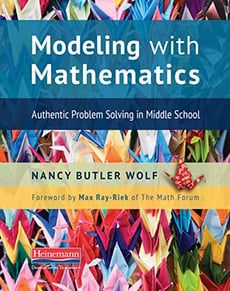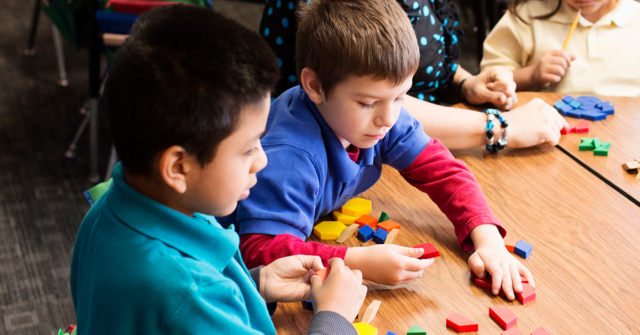
Rich mathematical tasks are essential for engaging learners and creating dynamic classrooms. In this post—adapted from her book, Modeling with Mathematics—Nancy Butler Wolf looks at six characteristics shared by the best math tasks.
How do we know a good task from a bad one? As teachers make the foray into mathematical modeling in their classrooms, it is important that they use rich and rewarding tasks. Unfortunately, too few textbooks contain such tasks, so teachers must scramble to find or develop their own. Here is a brief look at six important characteristics of rich modeling tasks:
Accessibility to All Learners
The first characteristic should be obvious to almost any teacher in almost any classroom: the students in the desks in front of us come with a wide range of foundational knowledge, mathematics background, and experience with mathematics. If a task is truly rich, it will provide interest, motivation, and challenge for all our learners. It will not encourage our most struggling students to opt out and allow the more proficient students to take over, provide direction, and supply solutions. By the same token, it will not be quickly and easily solved by more advanced math students, but will provide challenge and extensions for these learners as well. A good task will provide opportunities for all learners to contribute with confidence.
Real-Life Tasks
The second criterion for a rich task has been the subject of extensive discussion among teachers, mathematicians, and researchers for many years. What, exactly, is a task with some basis in real life? But the question remains: What is an authentic task? I would suggest that an authentic task is one with which students have some real-life experience. I have used many problem-solving and modeling tasks that are, admittedly, not “really real,” but are, nonetheless, interesting and engaging to students. For instance, mathematics with a literature connection can be very interesting and engaging to students despite the fact that the scenarios investigated would not be called “really real.” Remember, the objective is to present tasks that are interesting and can help students understand that the concepts they are learning in their math classrooms are not completely separate from their lives outside the classroom. Do not stifle your creativity by imposing false limits regarding what is a “real world” application. Students will be engaged by problems that spring from literature, from other subject areas, and from their imaginations, as well as from their “really real” lives!
Multiple Approaches and Representation
The third criterion of a rich math task is that it lends itself to a variety of approaches and representations. Our students approach mathematics from very different perspectives, and when we can recognize and respect that fact, we can provide more opportunities for students’ success. When a variety of approaches can lead to an appropriate solution, students can become confident in their abilities and learn from one another.
Collaboration and Disscussion
The fourth characteristic of a rich modeling task is that it encourages collaboration and discussion. The teaching strategies for modeling problems vary, but in every case should involve some degree of collaboration and discussion. Many tasks require students to first work independently, with guidance and encouragement from the teacher as needed. When students have reached an independent conclusion, they may share their results, approaches, and representations within collaborative groups and discuss the similarities and differences. Students gain new insights and perspectives by hearing from their peers; even struggling students begin to gain confidence in their ability to problem solve when given the opportunity to explain their reasoning on a problem.
Engagement, Curiosity, and Creativity
The next characteristics of a rich task are fairly self-explanatory and go hand in hand with each other as well as with other characteristics. When a task is interesting and engaging, and gives a problem that interests students, they will persevere in the problem solving. A rich task presents students with a variety of possible approaches and representations, allowing access for all learners. When students problem solve, they must first decide which tools and what approach to try. As the problem unfolds, students may run into obstacles and roadblocks that will require them to make more decisions both individually and collaboratively, and, often, will demand creativity and variety in the way they apply their knowledge.
Opportunities for Extension
The final characteristic of a rich modeling task is often the missing piece in problem-solving experiences in the classroom. We can probably all relate to the times we have presented students with an engaging task, only to find that one group finishes quickly while another group struggles with the problem. This can result in one of two scenarios: a frantic attempt to keep the more advanced group busy (or quiet) while the other group continues their work, or an attempt to hurry along the slower-paced group in order to keep everyone on task. A rich task keeps all students engaged by including challenges and extensions for more advanced learners to work out while other students continue to work without the pressure to “hurry up and finish.”
There are many sources for rich math tasks, including the MARS tasks, the 3-Act Math tasks, and the Illuminations problems. As you work with problems like this, it will become easier to recognize a good mathematical modeling task and develop your own rich mathematical experiences for your students, and you will begin to see the return on your investment of time and energy in the enthusiasm, motivation, and depth of understanding of your students.
Want to learn more about getting started or going deeper with mathematical modeling? Watch Nancy talk about why modeling is so effective or preview the first chapter of Modeling with Mathematics.
♦ ♦ ♦ ♦
Nancy Butler Wolf is a national math consultant and curriculum developer who has served as a member of NCTM’s Illuminations Writing Group. She has over 30 years of classroom teaching experience and has presented at various conferences on mathematical modeling and algebraic reasoning. Follow her on Twitter @drnanbut.



